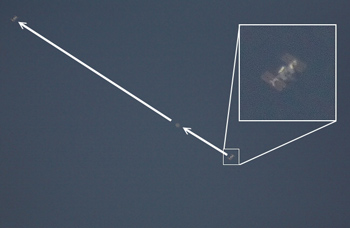The amazing pictures of the space station taken by ground-based amateur astronomers keeps on coming. On May 29th, Anthony Ayiomamitis used a 16 cm (6”) telescope to capture a phenomenal image of the International Space Station passing Jupiter… in broad daylight!
Wow! Note the color of the sky; it was about 9:00 a.m. local time when he took this shot, with the Sun well above the horizon. This is actually two images added together; the first shows the ISS to the lower right, and in the second shot it had moved to the upper left. Jupiter shows its disk near the center of the frame, it being easily bright enough to be seen using a telescope in daylight.
What an incredible picture! But it gets cooler…
 The picture on the right is the same shot, but this time he connected the two ISS images with a line. Given the size of both the ISS and Jupiter, it looks like the station flew directly in front of the planet from Anthony’s position! Had he taken that first shot literally a tenth of a second later, he would have had the picture of a lifetime. As it is, it’s still way cool.
The picture on the right is the same shot, but this time he connected the two ISS images with a line. Given the size of both the ISS and Jupiter, it looks like the station flew directly in front of the planet from Anthony’s position! Had he taken that first shot literally a tenth of a second later, he would have had the picture of a lifetime. As it is, it’s still way cool.
Want more? I got more.
Robert Vanderbei, at Princeton University, took this picture of Jupiter, also in daylight. You can see the moons!
The picture has the moons labeled. Ganymede and Europa are faint, but visible. For an added coolness, Io was poised right on the limb of the planet’s disk. You can see the Red Spot, and also how the southern equatorial belt of Jupiter is missing (it should be at about the same latitude as the Red Spot). To get this Robert used a 9 cm (3.5”) Questar ‘scope, which is small but has very nice optics.
And one more, but it’s a link: Universe Today is reporting that an amateur got shots of the Air Force X37-B in orbit!
All this goes to show that the word “amateur”, as I’ve been saying for years, is losing its meaning. Like everything in nature, when you get near the boundary between two entities, the lines get blurry. I know lots of so-called amateurs who have a far keener grasp of the sky and the objects in it than some professionals. Astronomy is one of the few sciences where someone with even modest equipment can do phenomenal work in the field. I love it, and it’s a great time to be an astronomer!
Image credits: Anthony Ayiomamitis, Robert Vanderbei, used by permission.